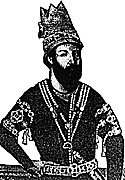 Born in 1688, Nadir Shah was one of the greatest conquers and one of the worst kings in Persian history. Nadir Qoli Beg had an obcure beginning in the Turkish Afshar tribe which was loyal to the Safavid Shahs of Persia. After serving as a local chieftain, Nadir formed and led a band of robbers, showing a great gift for leadership.
Born in 1688, Nadir Shah was one of the greatest conquers and one of the worst kings in Persian history. Nadir Qoli Beg had an obcure beginning in the Turkish Afshar tribe which was loyal to the Safavid Shahs of Persia. After serving as a local chieftain, Nadir formed and led a band of robbers, showing a great gift for leadership.
In 1726, as head of this bandit army, he led 5,000 warriors in support of the Safavid Shah Tahmasp II, who was seeking to regain the throne his father had lost four years earlier to the Afghan usurper Mahmud. Nadir reformed the Persia military forces and in a series of brilliant victories, totally defeated Mahmud and restored Tahmasp to the throne.
Nadir then attacked and routed the Ottomans who had occupied adjacent areas of Azerbaijan and Iraq. He then surpressed a revolt in Khorasan. However, while he was absent, Tahmasp rashly attacked the Ottomans and was heavily defeated, undoing much of Nadir's earlier success.
Enraged by the Shah's actions, Nadir hurried back and deposed Tahmasp. He placed Tahmasp's infant son on the throne and declared himself regent. His first attack on the Ottomans met with defeat, but he soon recovered and drove them completely out of Persia. He then used the threat of war to force the Russians to relinquish their Caspian provinces.
In 1736 he deposed Tahmasp's son and declared himself Shah. With the navy he proceeded to build, he took both Bahrain and Oman. He then turned to India, and after taking several cities of the Mughal Empire in northern India, he met the main Mughal army at Karnal. Following his victory he entered Delhi and then returned to Persia with vast loot, including the fabulous Peacock Throne and the Koh-i-noor diamond. He then attacked the Uzbeks around the cities of Bukhara and Khiva. His empire now rivaled the greatest Persian empires of the past in terms of size.
In 1741, following an unsuccessful assassination attempt, Nadir Shah suspected his son and had him blinded. He also attempted to force the largely Shiite population of Persia to adopt the Sunni form of Islam.
Back at the Ottomans
In 1743 he again attacked the Ottomans, but revolts at home forced hims to conclude a truce. After quelling the revolts he returned to his war with the Ottomans, winning a great victory near Yerevan. Peace was concluded in 1746.
Although brilliantly successful as a soldier, Nadir Shah had little talent for statesmanship or administration, and Persia became utterly exhausted during the later years of his reign. Tens of thousands of people perished in his ceaseless military campaigns and the exactions of his tax gatherers ruined the economy.
Nadir Shah had always been harsh and ruthless, but these traits became increasingly pronounced as he grew older. His suspiciousness and capricious cruelty continued to grow, and wherever he went he had people tortured and executed with the consequence that the people rose in revolt against him again and again. In the end he was assassinated by his own troops while attempting to crush yet another uprising in Khorasan.
Nadir Shah's only real interests were war and conquests. Once, when informed that there was no warfare in paradise, he is said to have remarked; "How then can there be any delights there?"
Related
Back to Dragoman Vol. 2 No. 1 Table of Contents
Back to Dragoman List of Issues
Back to MagWeb Magazine List
© Copyright 1997 by William E. Johnson
This article appears in MagWeb (Magazine Web) on the Internet World Wide Web. Other military history articles and gaming articles are available at http://www.magweb.com